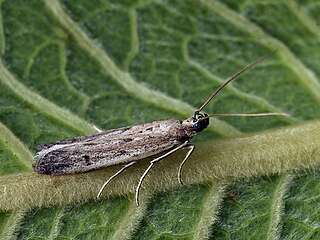
The Pyralidae, commonly called pyralid moths, snout moths or grass moths, are a family of Lepidoptera in the ditrysian superfamily Pyraloidea. In many classifications, the grass moths (Crambidae) are included in the Pyralidae as a subfamily, making the combined group one of the largest families in the Lepidoptera. The latest review by Eugene G. Munroe and Maria Alma Solis retain the Crambidae as a full family of Pyraloidea.

The Pyraloidea are a moth superfamily containing about 16,000 described species worldwide, and probably at least as many more remain to be described. They are generally fairly small moths, and as such, they have been traditionally associated with the paraphyletic Microlepidoptera.

Ancylolomia tentaculella is a species of moth of the family Crambidae.

In biological taxonomy, circumscription is the content of a taxon, that is, the delimitation of which subordinate taxa are parts of that taxon. For example, if we determine that species X, Y, and Z belong in genus A, and species T, U, V, and W belong in genus B, those are our circumscriptions of those two genera. Another systematist might determine that T, U, V, W, X, Y, and Z all belong in genus A. Agreement on circumscriptions is not governed by the Codes of Zoological or Botanical Nomenclature, and must be reached by scientific consensus.

Micromartinia is a genus of moths in the family Crambidae. It contains only one species, Micromartinia mnemusalis, which is found in Costa Rica, Brazil, French Guiana and Venezuela.
Paracorsia is a monotypic moth genus of the family Crambidae described by H. Marion in 1959. It contains only one species, Paracorsia repandalis, described by Michael Denis and Ignaz Schiffermüller in 1775. It is found in most of Europe, except Ireland, Fennoscandia and the Baltic region. It has also been recorded from central Asia, including Iran and Kyrgyzstan and North America where it has been recorded in southern Ontario and northern Indiana.

Prochoristis is a genus of moths of the family Crambidae.

Sclerocona is a genus of moths of the family Crambidae which contains only one species, Sclerocona acutella. It was first described by the Prussian biologist Eduard Friedrich Eversmann in 1842.

Homoeosoma nebulella, the Eurasian sunflower moth, is a moth of the family Pyralidae. It is found in Europe, Russia, Anatolia, the Middle East and West Africa. The wingspan is 20–27 mm.

Homoeosoma nimbella is a moth of the family Pyralidae. It is found in Europe.

Monodonta is a genus of moths of the family Crambidae. It contains only one species, Monodonta passalis, which is described from Mount Kebea in New Guinea. The genus name is a junior homonym of Monodonta Lamarck, 1799 but no replacement name is currently available.

The Anerastiini are a tribe of moths of the family Pyralidae.

Prochoristis crudalis is a species of moth in the family Crambidae. It is found on Cyprus, as well as in Syria.

Agriphila poliellus is a species of moth in the family Crambidae described by Georg Friedrich Treitschke in 1832. It is found in most of Europe, Turkey, Iran, the Ural, Dagestan, Kazakhstan and Central Asia. Its type locality is in Hungary.

Cybalomiinae is a subfamily of the lepidopteran family Crambidae. It was described by Hubert Marion in 1955.

Glaphyriinae is a subfamily of the lepidopteran family Crambidae. It was described by William Trowbridge Merrifield Forbes in 1923. The subfamily currently comprises 509 species in 75 genera.
Prochoristis rupicapralis is a moth in the family Crambidae. It is found in Lebanon, Syria, Turkmenistan and the United Arab Emirates.
Prochoristis malekalis is a moth in the family Crambidae. It is found in Iran.
Zebronia phenice is a moth in the family Crambidae. It was described by Stoll in 1782. It is found in Cameroon, Mayotte, the Democratic Republic of Congo, Equatorial Guinea, Ethiopia, Gabon, Ghana, Ivory Coast, Kenya, La Réunion, Madagascar, Mauritius, Mozambique, Nigeria, Senegal, Sierra Leone, South Africa, Tanzania, Gambia, Uganda, Zambia and Zimbabwe.

Lineodini is a tribe of the species-rich subfamily Spilomelinae in the snout moth family Crambidae.










